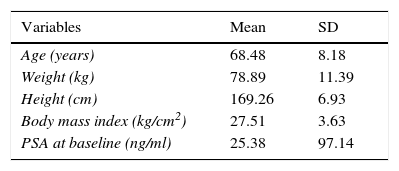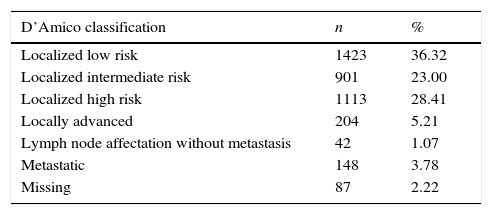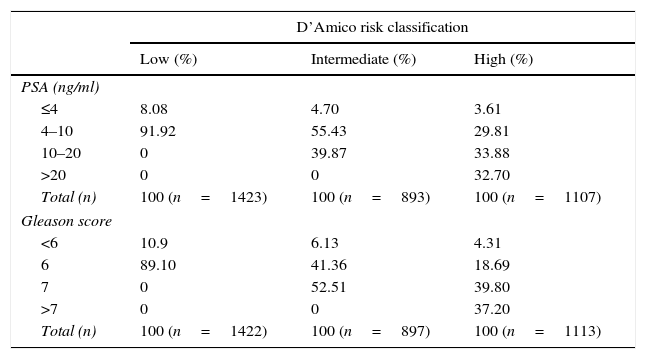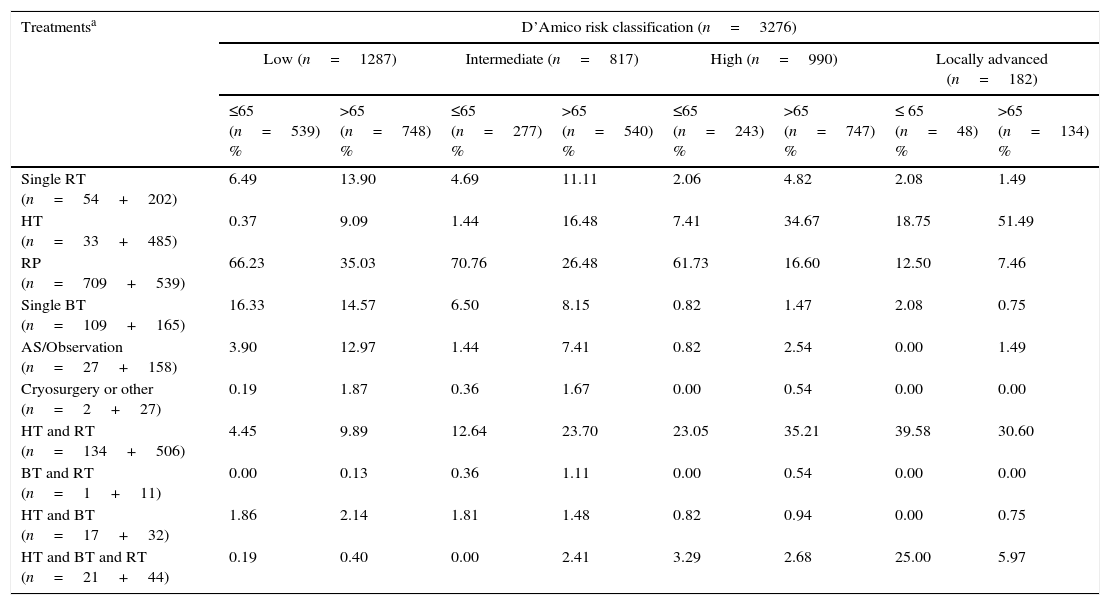To assess the adherence to European Association of Urology (EAU) guidelines in the management of prostate cancer (PCa) in Spain.
Patients and methodsEpidemiological, population-based, study including a national representative sample of 3918 incident patients with histopathological confirmation during 2010; 95% of the patient's sample was followed up for at least one year. Diagnosis along with treatment related variables (for localized PCa – low, intermediate, high and locally-advanced by D’Amico risk stratification) was recorded. Differences between groups were tested with Chi-squared and Kruskal–Wallis tests.
ResultsMean (SD) age of PCa patients was 68.48 (8.18). Regarding diagnostic by biopsy procedures, 64.56% of all patients had 8–12 cores in first biopsy and 46.5% of the patients over 75 years, with PSA<10ng/ml were biopsied. Staging by computer tomography (CT) or bone scan (BS) was used for determining tumor extension in 60.09% of high-risk cases and was applied differentially depending on patients’ age; 3293 (84.05%) patients received a treatment for localized PCa. Radical prostatectomy was done in 1277 patients and 206 out of these patients also had a lymphadenectomy, being 4.64% low-risk, 22.81% intermediate-risk and 36.00% high-risk patients; 86.08% of 1082 patients who had radiotherapy were treated with 3D or IMRT and 35.77% received a dose ≥75Gy; 419 patients were treated with brachytherapy (BT): 54.81% were low-risk patients, 22.84% intermediate-risk and 12.98% high-risk. Hormonotherapy (HT, n=521) was applied as single therapy in 9.46% of low-risk and 17.92% of intermediate-risk patients. Additionally, HT was combined with RT in 14.34% of lower-risk patients and 58.26% of high-risk patients, and 67.19% low-intermediate risk with RT and/or BT received neoadjuvant/concomitant/adjuvant HT. Finally, 83.75% of high-risk patients undergoing RT and/or BT also received HT.
ConclusionsAlthough EAU guidelines for PCa management are easily available in Europe, the adherence to their recommendations is low, finding the highest discrepancies in the need for a prostate biopsy and the diagnostic methods. Improve information and educational programs could allow a higher adherence to the guidelines and reduce the variability in daily practice (Controlled-trials.com: ISRCTN19893319).
Evaluar la adherencia a las guías de la Asociación Europea de Urología (EAU) en el manejo del cáncer de próstata (CaP) en España.
Pacientes y métodosEstudio epidemiológico poblacional que incluyó una muestra representativa a nivel nacional formada por 3.918 pacientes con diagnóstico nuevo y confirmación histopatológica durante el año 2010; de estos pacientes, al 95% se les realizó un seguimiento mínimo de un año. Se registró el diagnóstico junto con las variables relacionadas con el tratamiento (para el CaP localizado de riesgo bajo, intermedio, alto o localmente avanzado, según la estratificación de riesgo de D’Amico). Las diferencias entre los grupos se evaluaron mediante pruebas de Chi-cuadrado y Kruskal-Wallis.
ResultadosLa media (DE) de la edad de los pacientes con CaP fue de 68,48 (8,18) años. En relación con los procedimientos diagnósticos, en el 64,56% de los pacientes se disponía de 8-12 cilindros en la primera biopsia y se realizó biopsia al 46,5% de los pacientes mayores de 75 años con PSA<10ng/ml. Se utilizó tomografía computarizada o gammagrafía ósea para determinar la extensión tumoral en el 60,09% de los casos de alto riesgo; estas técnicas se aplicaron diferencialmente en función de la edad de los pacientes; 3.293 pacientes (84,05%) recibieron tratamiento para el CaP localizado. Se realizó prostatectomía radical a 1.277 pacientes; de ellos, 206 fueron también sometidos a linfadenectomía, siendo el 4,64% de los pacientes de bajo riesgo, el 22,81% de riesgo intermedio y el 36,00% de alto riesgo. El 86,08% de los 1.082 pacientes que recibieron radioterapia fueron tratados con 3D o RTIM y el 35,77% recibieron una dosis ≥75Gy; 419 pacientes fueron tratados con braquiterapia (BT), el 54,81% fueron pacientes de bajo riesgo, el 22,84% de riesgo intermedio y el 12,98% de alto riesgo. La terapia hormonal (TH, n=521) se utilizó como monoterapia en el 9,46% de los pacientes de bajo riesgo y en el 17,92% de los pacientes de riesgo intermedio. Además, la TH se combinó con RT en el 14,34% de los pacientes con bajo riesgo y en el 58,26% con alto riesgo; el 67,19% de los pacientes de riesgo intermedio con RT y/o BT recibieron TH neoadyuvante/concomitante/adyuvante. Por último, el 83,75% de los pacientes de alto riesgo que recibieron RT y/o BT también recibieron TH.
ConclusionesAunque las guías EAU para el manejo del CaP están disponibles en Europa, la adherencia a sus recomendaciones es baja; las mayores discrepancias se refieren a la necesidad de las biopsias de próstata y a los métodos diagnósticos. Una mayor información y programas educacionales podrían mejorar la adherencia a las guías y reducir la variabilidad en la práctica diaria (Controlled-trials.com: ISRCTN19893319).











